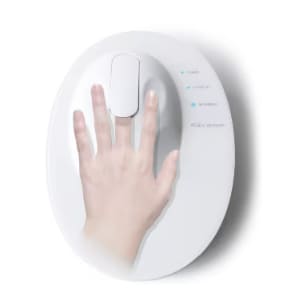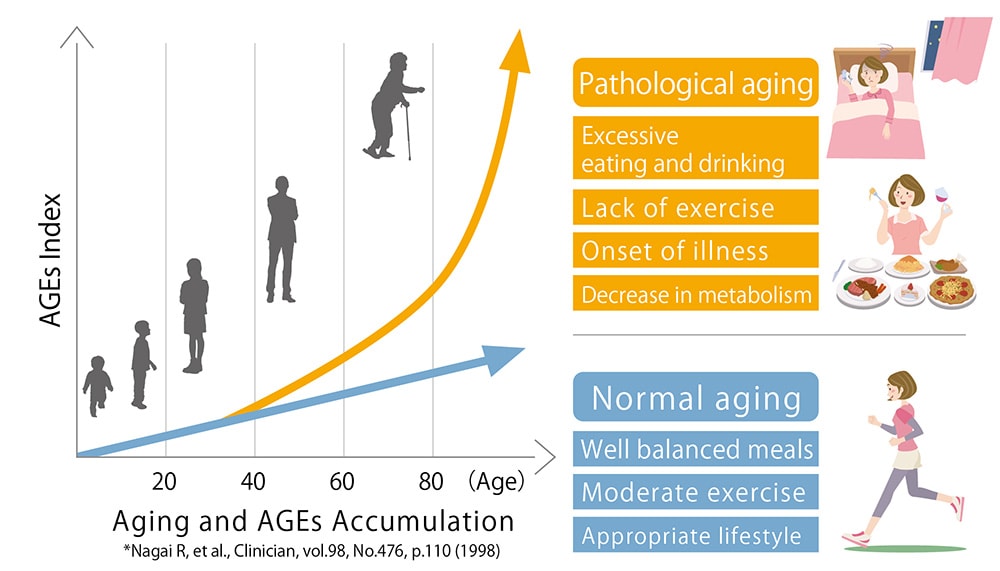Is Controlling Aging the Key to Extending Healthy Lifespan?
Healthcare in the Era of the 100-Year Human Lifespan
About 120 years ago at the start of the 20th century, people’s average lifespan worldwide was approximately 31 years*1. According to world health statistics, at present, this has lengthened to approximately 73 years*2. In the midst of what could be called the era of the 100-year human lifespan, extending not only lifespan as a whole but also the healthy lifespan, which refers to how long someone is in good health, is attracting attention. The concept of aging is indispensable when considering the topic of healthy lifespan.

What is Aging?
The human body contains approximately 37 trillion cells*3. When these cells become too old, they are eliminated, and new cells are produced. As the years go on, cell replacement slows, and the number of cells decreases, weakening the body’s working. This phenomenon is called aging.
The aging process, which occurs as the years wear on, occurs at the same rate for everyone, yet this does not mean that the speed of aging is the same. The age at which the signs of aging appear including blurred vision, hearing loss, and an increase in wrinkles, differs depending on the person. There are large individual differences in the speed of aging, just as there are in the growth of the body, and there are differences between cells and between positions in the body. As aging advances, physical strength, immune response, and cognitive functioning all decrease, and the risk of various diseases is heightened. An important topic in research is to clarify the mechanisms of aging, to extend a healthy lifespan.
In recent years, people have come to see aging as a disease that can be treated and prevented. It is known that the speed of aging reflects both inheritable and acquired characteristics. It is evident that lifestyle improvements including exercise and food can delay aging, and even reverse the signs of aging, enabling a degree of control. Up to now, it was believed that aging could be slowed but not stopped, but even that notion is starting to change.
AGEs Sensors Render Aging Related Substances Visible
Shimadzu Corporation is promoting the development of solutions related to aging. AGEs sensors enable people to quickly measure the accumulation of advanced glycation end-products (AGEs), substances associated with aging, in their body simply by placing their fingers on the measuring instrument. AGEs are formed when proteins in the body become linked to excess dietary sugars. AGEs increase in the body and accumulate as we age. They are of interest as they are one factor that promotes aging in every part of the body including the brain, heart, blood vessels, bones, and skin. AGEs increase due to poor lifestyle choices and stress, and so their increase can be controlled by paying attention to our diet, amount of exercise, and sleep. Consistently measuring the state of the body can help us improve and maintain our quality of health.

AGEs Sensor
- (*It is only available in Japan and not a medical device.)

The accumulation of AGEs increases as we age
New Substances to Prevent Aging
A few percent of the oxygen that people take in by breathing becomes reactive oxygen. Reactive oxygen acts to maintain immune response and is indispensable to the body. However, surplus reactive oxygen resulting from poor lifestyle choices and stress is one factor that accelerates the speed of aging. Supersulfides, which exist everywhere in the body, have strong antioxidant properties and are known to control the action of reactive oxygen.
In April 2024, Shimadzu Corporation and Tohoku University established the Shimadzu × Tohoku University Supersulfides Life Science Co-Creation Research Center. Here, supersulfides are measured using Shimadzu instruments in conjunction with the team of Professor Takaaki Akaike, a pioneer in supersulfide research, of Tohoku University (Department of Environmental Medicine and Molecular Toxicology, Graduate School of Medicine). For example, high-performance liquid chromatograph mass spectrometers (LC-MS) can measure both the type and amount of trace components in blood, pharmaceuticals, and food products. Measuring supersulfides in blood helps to clarify how they prevent aging in the body. In the future, the aim is to contribute to understanding the aging mechanism, and to developing pharmaceuticals and food products to prevent aging.

LCMS-8060NX High-Performance Liquid Chromatograph Mass Spectrometer Used to Measure Supersulfides
There are still many aspects of aging that have yet to be clarified. Shimadzu will continue to work to develop solutions for clarifying the mechanisms of aging and preventing aging, with the goal of achieving a society of people with healthy longevity.
References
- *1: Development Centre Studies: The World Economy: Volume 1: A Millennial Perspective and Volume 2: Historical Statistics
- *2: World Health Statistics 2023 (WHO Data)
- *3: An estimation of the number of cells in the human body (researchgate.net)
 Page Title and URL Copied.
Page Title and URL Copied.


